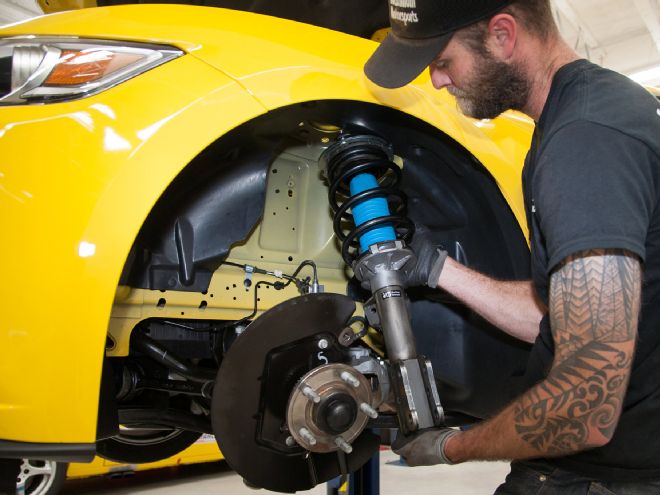
The scenario is all too common in the Mustang world. An enthusiast installs aftermarket performance lowering springs only to be left with alignment specs that can’t be fixed with the factory components. In most cases the unfixable alignment specs are so bad that they’re easily spotted with the naked eye, as evidenced by the angle of the wheels in relation to the horizon, and can be felt from the driver’s seat, as it likely pulls to one side or is highly unstable at speed. In some cases it’s not so extreme and thus not immediately evident, but uneven and premature tire wear are signs all is not well in the alignment world.
Thankfully there’s a fix. To our knowledge, Maximum Motorsports was not only the first company to make independently adjustable caster/camber plates for the Fox-body back in 1993, but it is currently the only company making them for the S550 that are street-friendly and track-ready, and that utilize stock-style springs.
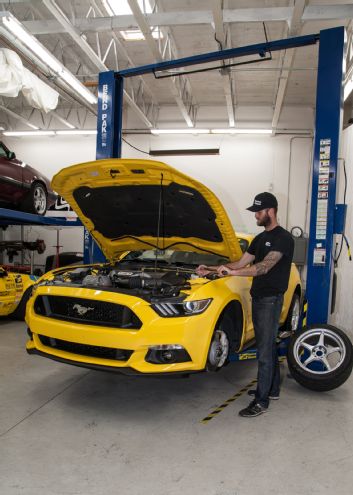 We paid a visit to the Maximum Motorsports headquarters to follow along with the installation of the company’s new caster/camber plates for the 2015 S550 Mustang.
We paid a visit to the Maximum Motorsports headquarters to follow along with the installation of the company’s new caster/camber plates for the 2015 S550 Mustang.
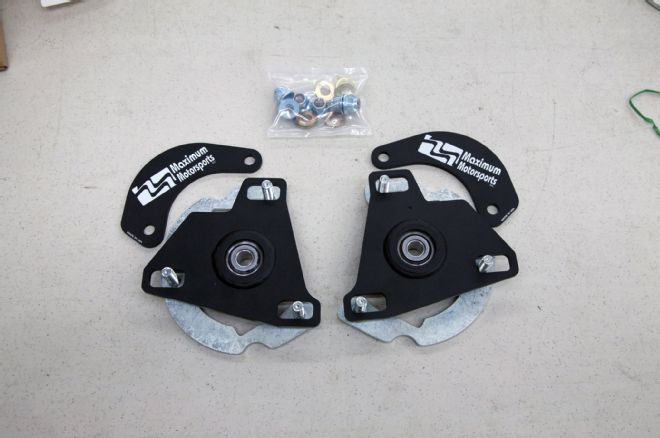 To our knowledge, MM is currently the only company selling caster/camber plates for the new S550 chassis. The high-quality units come with everything needed to set your suspension angles right, especially on lowered cars.
To our knowledge, MM is currently the only company selling caster/camber plates for the new S550 chassis. The high-quality units come with everything needed to set your suspension angles right, especially on lowered cars.
Caster and Camber 101
While this might be a bit repetitive for most of you, we should at least brush up on the alignment basics, especially in regards to caster and camber.
Caster is the angle of the imaginary line from the upper-strut mount down through the lower ball joint. In the case of the MacPherson-equipped Mustangs, it’s the angle from the top of the strut mount down to the ball joint pivot when seen from the side of the car. For those with a two-wheeled background, caster is best understood as the rake of the fork on a chopper when viewed from the side.
When the top of the strut is behind the lower ball joint, which is nearly always the case with modern Mustangs, this is called positive caster. Without getting into a lengthy explanation, positive caster promotes stability and self-centering of the front tires by placing the steering pivot point of the wheels in front of the contact patch.
Negative caster is best described as a bicycle with the forks bent backwards, behind the steering stem, which makes the steering darty and nervous at speed.
Caster and camber also have a working relationship since positive caster produces more negative camber on the outside wheels, which leads to more stability and grip in the corners.
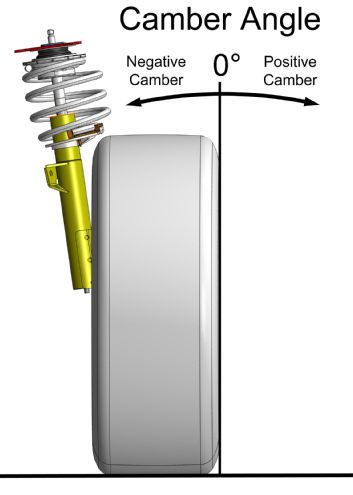 Before diving into the install, let us revisit camber. In short, camber is the side-to-side angle (or tilt) of the wheel (and MacPherson strut on a Mustang) when viewed from the front of the car. The top of the wheel tilted inwards is considered negative camber. When the top of the wheel tilts toward the outside of the car, that is positive camber.
Before diving into the install, let us revisit camber. In short, camber is the side-to-side angle (or tilt) of the wheel (and MacPherson strut on a Mustang) when viewed from the front of the car. The top of the wheel tilted inwards is considered negative camber. When the top of the wheel tilts toward the outside of the car, that is positive camber.
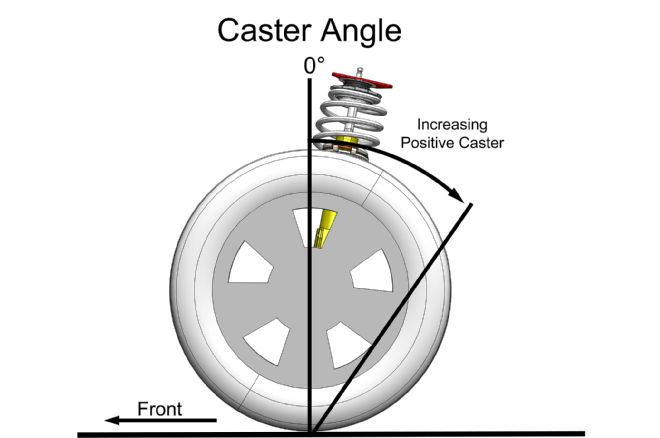 Caster on our S550 Mustang is the imaginary line from the top of the strut down to the spindle when seen from the side of the car. For those with a two-wheeled background, the rake of the fork on a chopper when viewed from the side is essentially the caster.
Caster on our S550 Mustang is the imaginary line from the top of the strut down to the spindle when seen from the side of the car. For those with a two-wheeled background, the rake of the fork on a chopper when viewed from the side is essentially the caster.
Speaking of camber; it’s the side-to-side tilt of the wheel when viewed from the front of the car. If the top of the wheel is tilted inward toward the center, it’s known as negative camber. Think about drift cars with their wheels tilted in—that’s negative camber at its finest. Conversely, when the top of the tire leans outward, away from the center of the car, that’s positive camber.
While there are exceptions to every rule, some negative camber is desirable on street cars in general since tire sidewall deflection and geometry changes during suspension travel negate up to 1.5 degrees of negative camber, translating into neutral camber and the widest contact patch at the outside tire when cornering.
Like caster, the degree of camber is dependent on the intended use. The greater the degree of negative camber, the quicker the steering response, since a tilted tire wants to roll in a circle rather than in a straight line. This helps during corner carving but can make the vehicle more nervous and darty in a straight line since the steering wheel can pull during bumps and undulations in the road. Again, a neutral tire is more stable in a straight line but is less advantageous for max-effort corner-carving where the right blend of positive caster and negative camber creates a car that is stable at speed and steady in the corners. It’s also important to note that extreme negative camber adds premature wear to the inside edges of the tire, unless the car is cornered very vigorously.
Mustang Front Suspension Explained
Without exploding into an engineering dictation with diagrams, long-winded mathematical equations, and midterm tests, let us explain the basic architecture of the front suspension utilized on the S550 Mustang.
Since the Fox-body hit showroom floors, the Mustang has utilized a modified MacPherson strut front suspension system that was effective and affordable. That is, it was affordable until the 2015 Mustang was introduced. The S550 builds on the tried and true MacPherson setup by adding a dual ball joint design for improved geometry preservation and the ability to package larger brakes. Again, we won’t get into virtual centers, scrub angle, and the many reasons why Ford went to a dual ball joint front suspension system on the S550, but understand it’s more versatile than a traditional McPherson strut setup.
As we are sure you already know, the traditional MacPherson strut suspension system used on the Fox-body through the S197 utilizes a shock absorber that doubles as both a damper and a suspension locating device. As it performs both of these functions, it is a strut, not just a shock absorber. Since the damper mounts to the chassis on the underside of the strut-towers and to the lower control arm by way of the spindle, it defines the top location of the suspension geometry.
This means that mounting a Maximum Motorsports adjustable caster/camber plate between the strut and the strut tower allows users to move the strut inboard or outboard and front to back, adjusting both caster and camber in the process.
Who Needs These Plates Anyway?
As we’ve already highlighted, those looking to maximize performance can benefit from precise alignment specs, but even for the cruisers in the crowd, dialing in your caster and camber is beneficial.
“While many believe that having the ability to tune caster and camber is reserved for road racers, drag racers and other performance applications stand to benefit from adjustable caster/camber plates. In the case of those with show cars or who care to drive at slower speeds, simply correct alignment specs saves wear and tear,” says Chuck Schwynoch, founder and CEO of Maximum Motorsports.
You see, even if you’re not the type to drive fast, launch hard, or hit the canyons, if you lower your car beyond the factory settings the alignment will be harmed.
“Lowering the vehicle beyond the factory settings changes the alignment specs,” says Schwynoch, “and the only way to bring it back into spec is with adjustable caster/camber plates.”
The Maximum Motorsports units replace the soft rubber upper strut bushing with a quality spherical bearing that precisely locates the strut shaft. Unlike the squishy OEM rubber bearing, which deflects under load and changes the alignment specs, the MM units eliminate the deflection. The result? A more stable and precisely controllable car in the corners and at the dragstrip. Drag racing? Yeah, drag racers benefit from the elimination of deflection so they can track straight and stay in the groove.
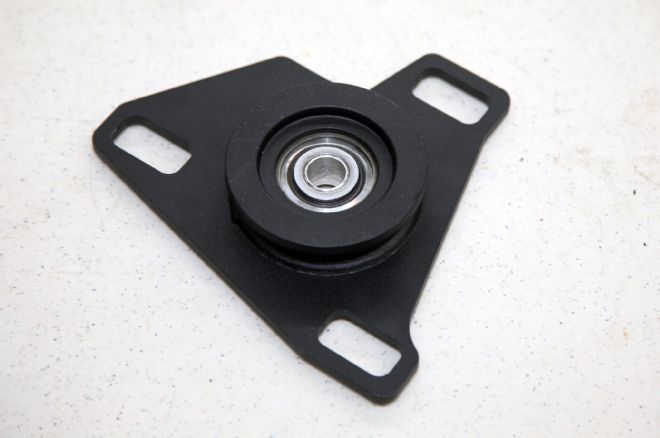 As with all MM parts, the new plates are of the highest quality and offer up to 1.75 degrees of continuous adjustment. Beyond the powdercoated and plated finishes, the PTFE lined spherical bearing is topnotch, as it eliminates deflection and locates the strut shaft while still preserving the required articulation. Oh yeah, the units come with a lifetime warranty against spherical bearing and bearing plate failures.
As with all MM parts, the new plates are of the highest quality and offer up to 1.75 degrees of continuous adjustment. Beyond the powdercoated and plated finishes, the PTFE lined spherical bearing is topnotch, as it eliminates deflection and locates the strut shaft while still preserving the required articulation. Oh yeah, the units come with a lifetime warranty against spherical bearing and bearing plate failures.
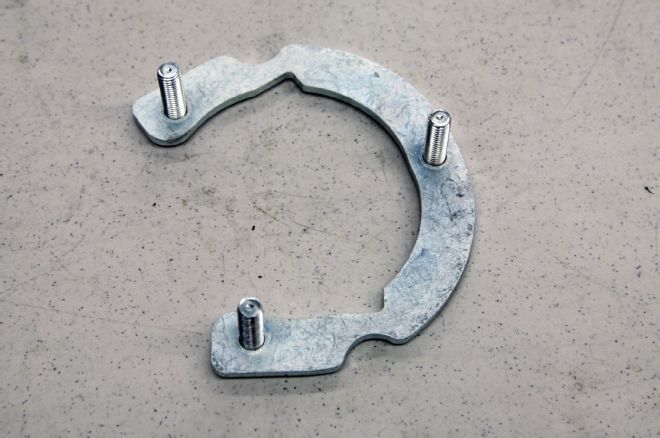 Here’s a closer look at the MM stud plate. It mounts between the bearing plate assembly and the OEM spring perch and rubber isolator.
Here’s a closer look at the MM stud plate. It mounts between the bearing plate assembly and the OEM spring perch and rubber isolator.
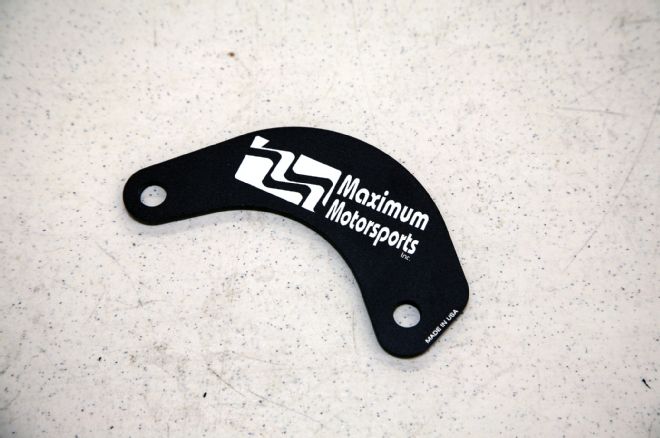 These included support brackets are about the only bits that mount atop the strut towers since there is so little room under the hood of the S550.
These included support brackets are about the only bits that mount atop the strut towers since there is so little room under the hood of the S550.
Precise Plates
OK, so we know there are many reasons for running adjustable caster/camber plates and that everyone from street cruisers to drag racers and road racers can benefit from them, but picking high-quality units is also of the utmost importance since maintaining a quality component for the upper strut assembly is, uh, a wee bit important.
As you already know, Maximum Motorsports is made up of more than just gearheads. These gearheads are also engineers hell-bent on performance perfection. Knowing the caliber of the ones behind-the-scenes at MM, it only makes sense that they would go the extra mile when designing the caster/camber plates for the S550.
Schwynoch says, “The impact loads can have devastating effects on the upper strut mount. Steel holds up better and for longer than aluminum, especially in the hazard-filled world of street driving. MM uses a couple of different high-grade steel alloys rather than mild steel.”
Beyond the laser-cut, high-grade steel alloy main plates and the rest of the quality components that are designed and custom made in the USA, how the components were designed also sets the MM units apart.
“Our custom-designed spherical bearings (that are made in the USA) hold up much longer than urethane bushings, and our caster/camber design offers the widest range of camber adjustment without cutting the strut tower top,” says Schwynoch.
In other words, the caster/camber plates take a lot of abuse and therefore should not be left to any second-rate components. As with all MM parts, it has been engineered well beyond what anyone can throw at it, which leaves the end user with peace of mind and the ability to maximize performance by way of a proper alignment.
Follow along as we highlight the install of the caster/camber plates at the Maximum headquarters in sunny San Luis Obispo, California.
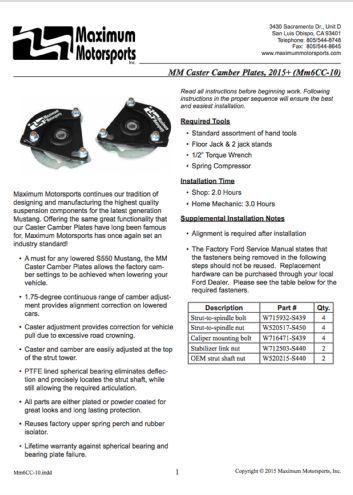 We don’t normally highlight instructions, but MM is legendary for its thorough instructions, which are written by a team of engineers and tech writers. Do yourself a favor and read the instructions—they’re that good.
We don’t normally highlight instructions, but MM is legendary for its thorough instructions, which are written by a team of engineers and tech writers. Do yourself a favor and read the instructions—they’re that good.
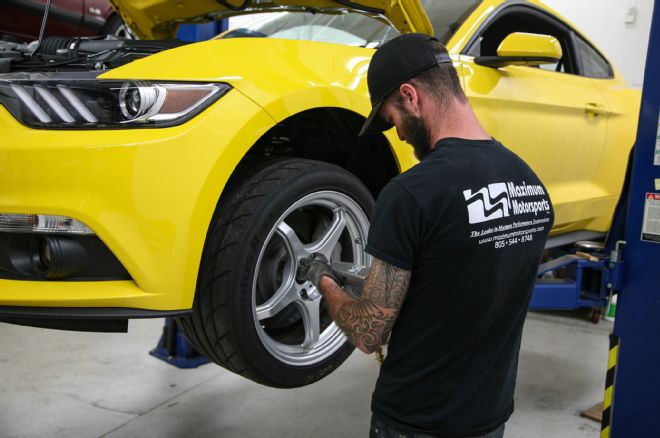
1. Kolton Sinclaire is the shop foreman at MM and was responsible for the tidy install. He started by removing the front wheels.
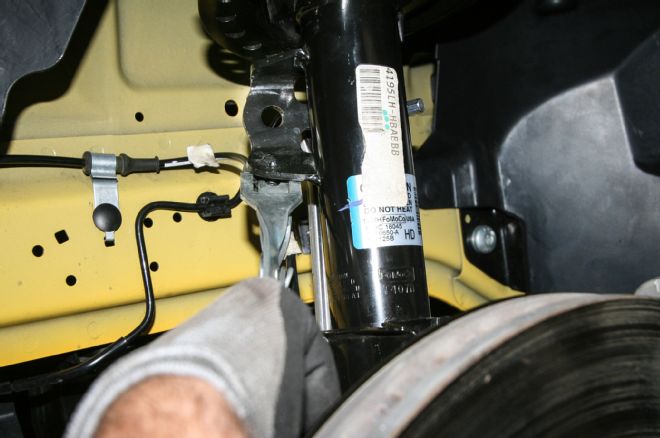
2. Next, the ABS sensor needs to be disconnected and the plastic mount removed from the strut.
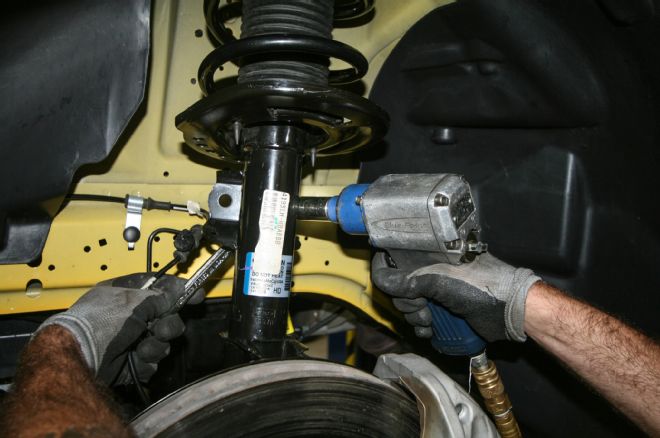
3. The sway bar endlinks are the next to leave the building.
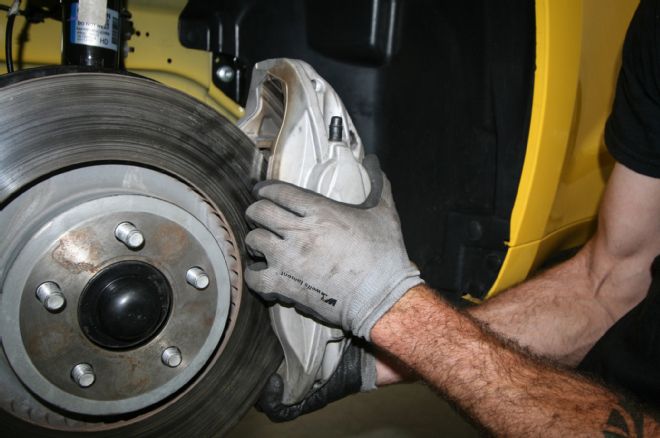
4. Now it’s time to remove the brake calipers. Rather than let them hang from their hoses, simply placing them on the lower control arms works well once they’ve been removed from their mounts.
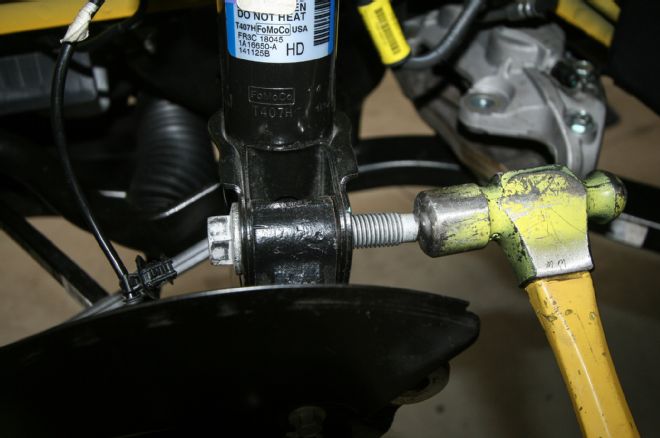
5. After removing the two spindle-to-strut bolts, lightly tapping them with a hammer makes removal easy.
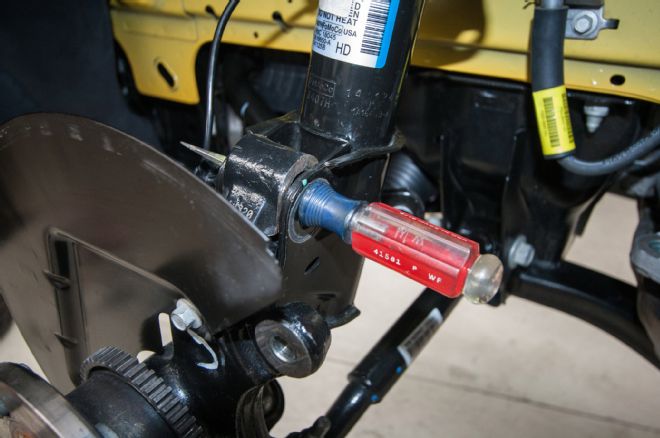
6. Using a screwdriver in place of one of the spindle bolts that were just removed will help with final removal later and also makes it easier to remove the upper strut-tower bolts.
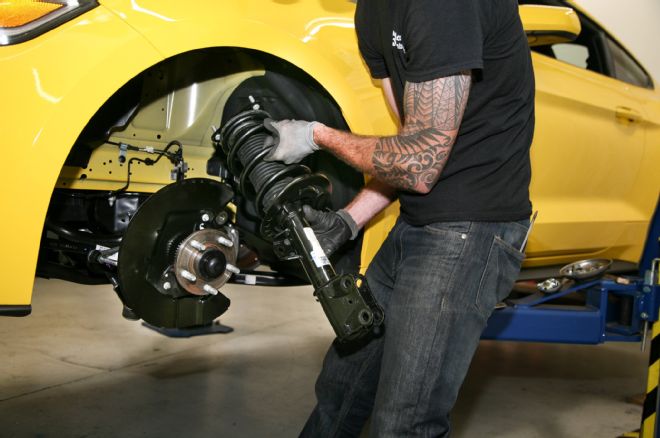
7. After the upper strut-tower bolts have been removed, the entire strut assembly can now be removed.
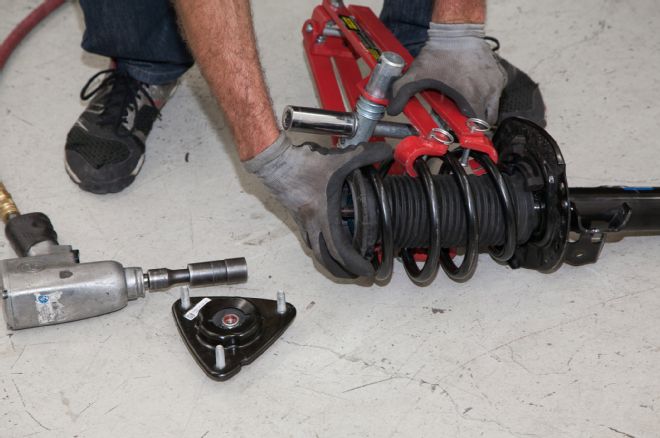
8. Be sure to use a proper spring compressor when removing the factory upper spring perch and rubber isolator. The MM6CC-10 caster/camber plates for the S550 reuse the factory upper spring perch and rubber isolator, which means NVH isn’t increased and replacement parts are affordable and readily available.
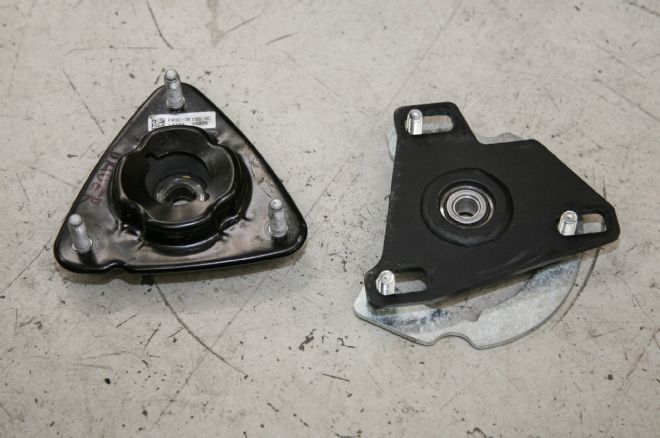
9. Stock squishy rubber or MM-equipped spherical bearing? The decision is easy! Note that the height difference is identical, which means ride height is unaffected. Part of the only reason MM was able achieve such an intricate part without increasing the height was the use of the new high-tech, high-strength steel straight from NASA.
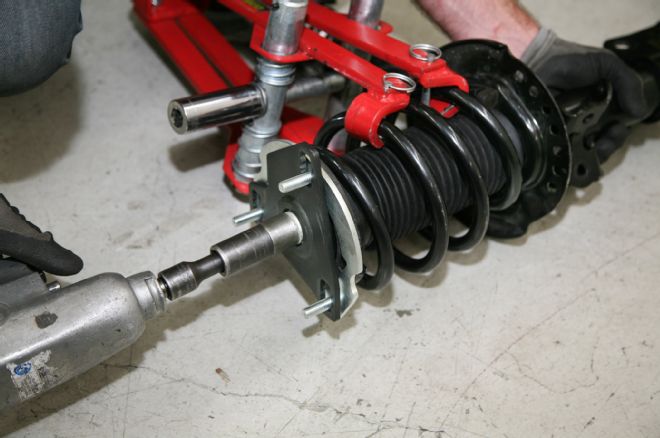
10. Now install the MM caster/camber plates in place of the factory upper mount. Of course, you’ll need that spring compressor again and an air gun always helps the process.
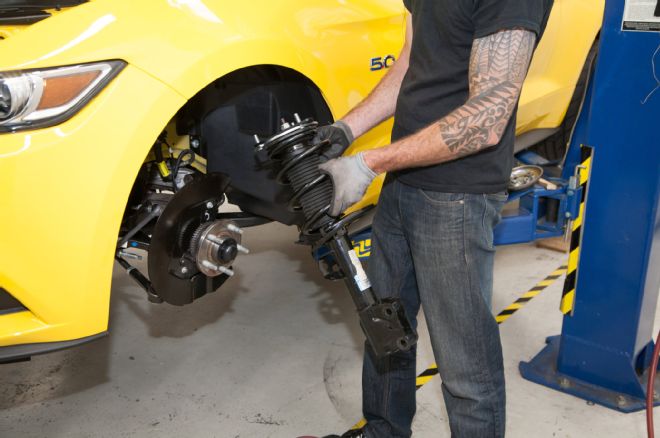
11. Now it’s time for the MM-equipped strut assembly to reenter the well. Installation is simply the reverse of removal.
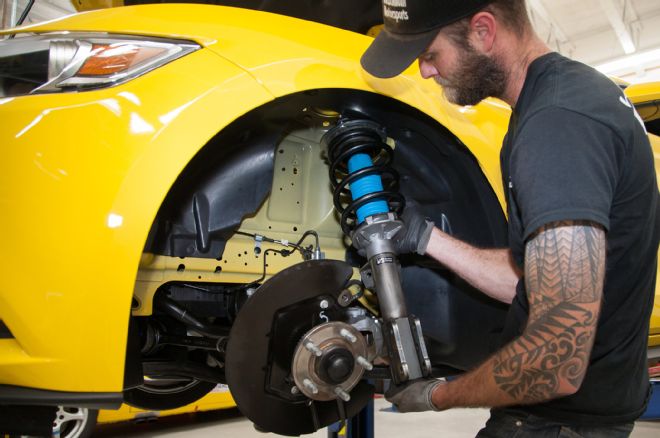
12. Look closely. We captured a sneak peek of a Maximum Motorsports prototype coilover body that utilizes stock style springs.
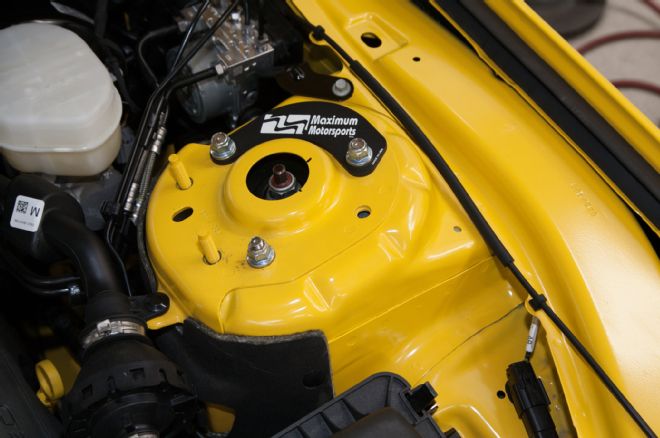
13. Don’t forget the reinforcement plate that mounts between the upper bolts and the strut towers. Now, caster and camber are easily adjusted at the top of the strut tower.